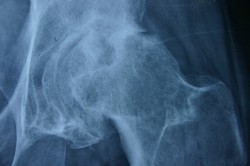Hip Osteoarthritis May Not Appear on X-ray
 Image courtesy of Alampaliam Venkatachalam on Flickr
Image courtesy of Alampaliam Venkatachalam on Flickr
These findings are the first to evaluate the diagnostic performance of an x-ray in patients with clinical signs and symptoms of classic OA. The study appears in the British Medical Journal.
Hip osteoarthritis (OA) is a significant source of morbidity causing pain, difficulty walking, and disability. More than 330,000 hip replacements are performed in the U.S. at a huge cost to the healthcare system. The population of people over age 60 has more than doubled in the past 30 years, and the total cost of OA (both treatment and complications) amount to $185.5 billion annually and is expected to rise exponentially.
Researchers looked at the Framingham Osteoarthritis and Osteoarthritis Initiative studies, with nearly 4,500 participants. In the Framingham study, only 16 percent of patients with hip pain had radiographic hip OA, and only 21 percent of hips with radiographic OA had hip pain. Results of the Osteoarthritis Initiative were similar with nine percent and 24 percent, respectively. In both study populations, hip pain was not present in many patients with radiographic OA, and many with hip pain did not have imaging evidence of hip OA.
“The majority of older subjects with high suspicion for clinical hip osteoarthritis did not have radiographic hip osteoarthritis, suggesting that many older persons with hip osteoarthritis might be missed if diagnosticians relied on hip radiographs to determine if hip pain was due to osteoarthritis,” explained corresponding author Chan Kim, MD, instructor of medicine at Boston University School of Medicine.
Missing the diagnosis of hip OA has consequences. According to Kim, up to 10 percent of patients with OA do not meet adequate physical activity recommendations, and are associated with having higher risk of developing heart or lung disease, diabetes, obesity and falls. “Given these findings, patients with suspected hip OA should be treated regardless of x-ray confirmation.”
Funding for this study was provided by grants from the National Institutes of Health (AR47785, NIH AG18393, NIH AR47785, NIAMS BAA-NHLBI-AR-10-06), the National Institute of Arthritis and Musculoskeletal and Skin Diseases (contract No. HHSN268201000019C), as well as private partners including Merck Research Laboratories; Novartis Pharmaceuticals Corporation, GlaxoSmithKline; and Pfizer, Inc.
View all posts